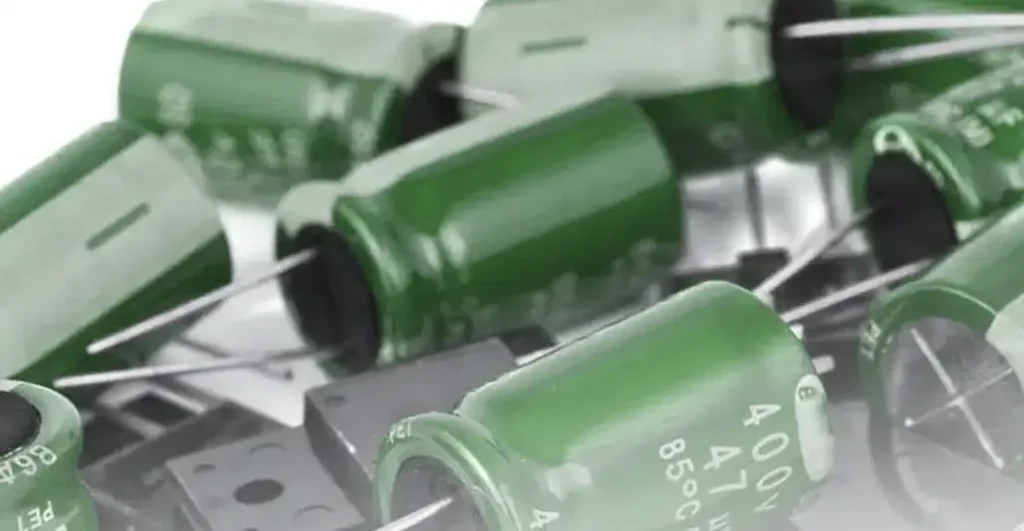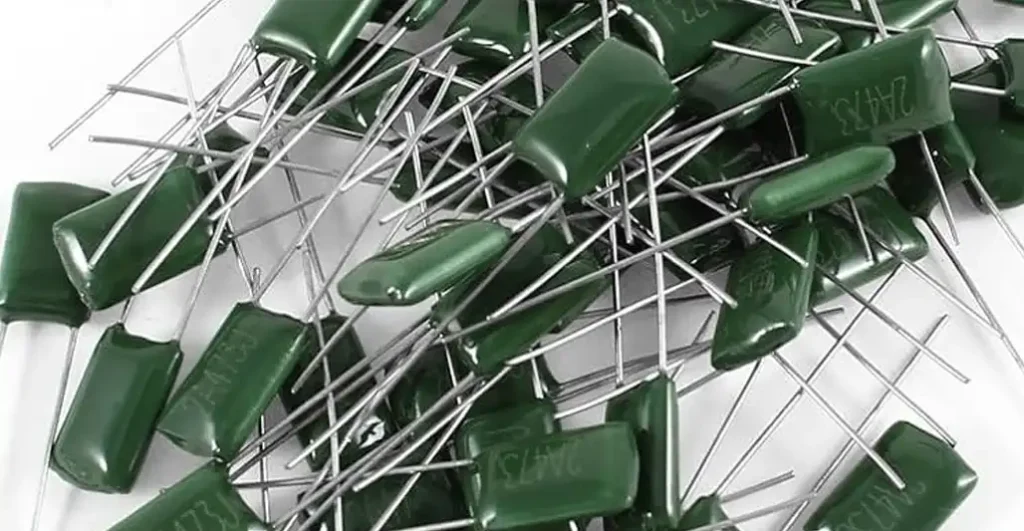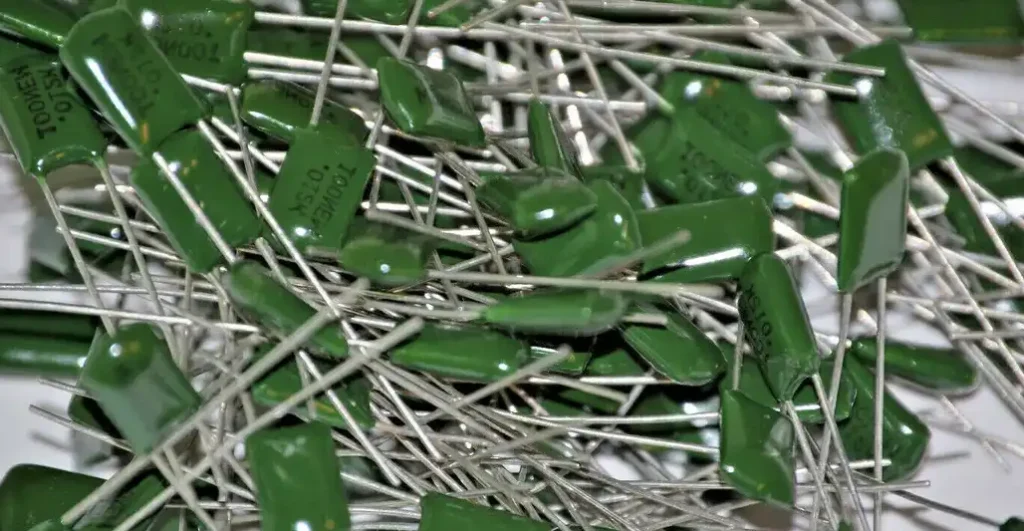Within the realm of electrical components, film capacitors occupy a significant role, offering a wide range of benefits and applications. These capacitors, constructed with thin dielectric films, provide excellent performance in terms of reliability, high voltage handling, and temperature stability. Join us as we explore the world of film capacitors, their design, characteristics, and applications.
What is a Film Capacitor

A film capacitor is an electrical component that stores and releases electrical energy. It consists of two metal electrodes separated by a thin dielectric film. The dielectric film can be made from various materials like polyester (PET), polypropylene (PP), polycarbonate (PC), polyethylene (PE), and more. Each material possesses unique properties that determine the capacitor’s performance characteristics.
Characteristics and Advantages of Film Capactor
High Voltage Handling:
Film capacitors can handle higher voltage levels compared to other capacitors, making them suitable for applications that require reliable performance under elevated electrical stress. They offer voltage ratings ranging from a few volts up to several kilovolts.
Reliable Performance:
Film capacitors are known for their excellent electrical insulation properties and robust functionality. They exhibit low dielectric losses, which minimizes energy dissipation, resulting in higher efficiency and power factor improvement. They are also resistant to overvoltage, voltage spikes, and surges, ensuring prolonged durability.
Temperature Stability:
Film capacitors maintain stable capacitance values over a wide temperature range, making them suitable for applications that involve temperature variations. The insulation resistance of film capacitors remains high, even at elevated temperatures, ensuring reliable performance and reducing the risk of failure.
Low Inductance:
Film capacitors have inherently low inductance, allowing them to handle high-frequency currents with reduced losses and enhanced performance. This property makes them suitable for applications where high-frequency noise reduction or filtering is required.
Self-Healing Property:
One of the unique features of film capacitors is their self-healing capability. If the dielectric film is subjected to localized breakdown due to voltage stress or mechanical stress, the capacitor repairs itself by vaporizing the thin conductive path within the film, maintaining the overall functionality of the device.
Film Capacitor Functions

The primary function of a film capacitor is to store and release electrical energy. It achieves this by utilizing a thin dielectric film between two metal electrodes. Let’s take a closer look at the main functions of film capacitors:
Energy Storage:
Film capacitors store electrical energy when they are charged with a voltage source. The dielectric film between the electrodes acts as an insulating material, preventing direct contact between the electrodes while allowing an electric field to form across the capacitor. This field results in the accumulation of electric charge, which is stored in the capacitor as energy.
Voltage Filtering:
Film capacitors play a crucial role in voltage filtering applications. As AC (alternating current) signals pass through a capacitor, the capacitor blocks the DC (direct current) component while allowing the AC component to pass through. This property makes film capacitors useful for removing unwanted voltage or noise in electronic circuits.
Decoupling and Bypassing:
Film capacitors are commonly used for decoupling and bypassing functions in electronic circuits. They provide a stable and low impedance path for high-frequency noise or voltage fluctuations to bypass sensitive circuit elements. This ensures reliable operation and protects sensitive components from disturbances.
Timing and Oscillation:
Film capacitors are employed in timing circuits and oscillators where accurate timing or frequency control is essential. They work in conjunction with resistors and inductors to set the desired timing or oscillation frequency.
Power Factor Correction:
Film capacitors are used for power factor correction, especially in applications where there is a significant amount of inductive load. By introducing a parallel capacitor in the circuit, they compensate for the reactive power generated by inductive loads, improving the power factor and maximizing the efficiency of electrical systems.
Coupling and Signal Transmission:
Film capacitors facilitate the coupling and transmission of AC signals in electronic circuits. They allow the AC component to pass through while blocking the DC component of the signal. This feature is useful in audio systems, amplifiers, and other circuits that require accurate signal transmission and low distortion.
Snubber Circuits:
Film capacitors are employed in snubber circuits to suppress voltage spikes and transients in power electronics systems. They absorb the excess energy generated during switching operations, protecting other components from damage and improving system reliability.
Energy Conversion:
Film capacitors play a role in energy conversion systems, such as inverters and converters. They assist in storing and delivering energy efficiently, ensuring smooth power conversion and reducing losses.
Film capacitors serve multiple functions in electronic and electrical circuits, including energy storage, voltage filtering, decoupling, timing, power factor correction, signal transmission, and protection against voltage spikes. Their diverse applications make them essential components in various industries and electronic devices.
What Are Film Capacitors Used For

Film capacitors are used in a wide range of electronic and electrical applications. Here are some common uses of film capacitors:
Power Electronics:
Film capacitors find broad applications in power electronic circuits such as output filters, snubber circuits, and DC link capacitors. Their high voltage ratings, low losses, and high surge current capabilities make them ideal for energy storage and power transmission in various industrial and commercial equipment.
Motor Drives:
Film capacitors play a crucial role in motor drive applications, where they are employed for motor starting and running, as well as for power factor correction. Due to their excellent self-healing properties and low inductance, film capacitors ensure efficient and reliable operation in electric motors.
Lighting Systems:
Film capacitors are extensively used in lighting applications, including fluorescent lamps, high-intensity discharge (HID) lamps, and LED drivers. They provide power factor correction, reduce current harmonics, and enhance overall energy efficiency.
Renewable Energy:
Film capacitors find application in renewable energy systems such as wind turbines and solar inverters. They help ensure smooth power conversion, enhance control over voltage and current fluctuation, and improve the overall efficiency of energy harvesting systems.
Audio Systems: High-quality audio systems and amplifiers utilize film capacitors for their accuracy in signal transmission, low distortion, and exceptional audio performance. They are deployed in audio coupling, filtering, and tone control circuits.
Are Film Capacitors Polarized
Film capacitors are polarized because they require a specific polarity when in use. The plate and the dielectric within film capacitors are charged up when electric current is passed, forming a particular polarity and preventing opposite electric charges from joining in them. This polarity has consequences concerning the capacitor’s working mode and its connection when hooking it up for practical implementations.
This electrical arrangement makes film capacitors work exceptionally well and meet essential requirements in critical and broad applications, such as low Equivalent Series Resistance (ESR), high stability with changing ambient temperatures and time aging factors, and high-temperature support.
When mounting these capacitors, knowing which positive and negative terminals it features makes a significant impact to ensuring long-lasting functional effectiveness by preventing damage while safeguarding the circuit assembly integrity against short-circuit potential instances.
In many circuits, film capacitors appear, mostly in power supplies’ decoupling, filter networks for suppressing noise, providing the transient voltage rise handling within switching power designs and protecting sensitive components for damage risks.
In all circuits, it is essential always to select the appropriate film capacitors meeting or exceeding the demanded tolerances on capacitance rating while aligning with the project application design requirements.
Conclusion
Film capacitors bring versatility, reliability, and high performance to various electrical and electronic applications. With their ability to handle high voltages, temperature stability, low inductance, and self-healing properties, these capacitors have become indispensable components in numerous industries, including power electronics, motor drives, lighting systems, renewable energy, and audio systems.
As technology advances, film capacitors continue to evolve, ensuring efficient and sustainable electrical energy storage and transfer.